For semiconductors, you'll want to use static shielding bags that provide multi-layer protection, including an inner static dissipative layer, middle aluminum layer, and outer polyester coating. These bags protect against ESD up to 20 kV while offering physical durability. Don't settle for basic pink anti-static bags, as they won't shield against external charges. Choose bags that meet ANSI/ESD standards and have proper moisture barrier properties with a WVTR ≤ 0.0003 g/100in2/24h. Consider your storage environment and handling requirements when selecting between metal-out shielding or moisture barrier options. Understanding the specific features of each bag type will guarantee the best protection for your components.
Understanding Static Control Bag Types
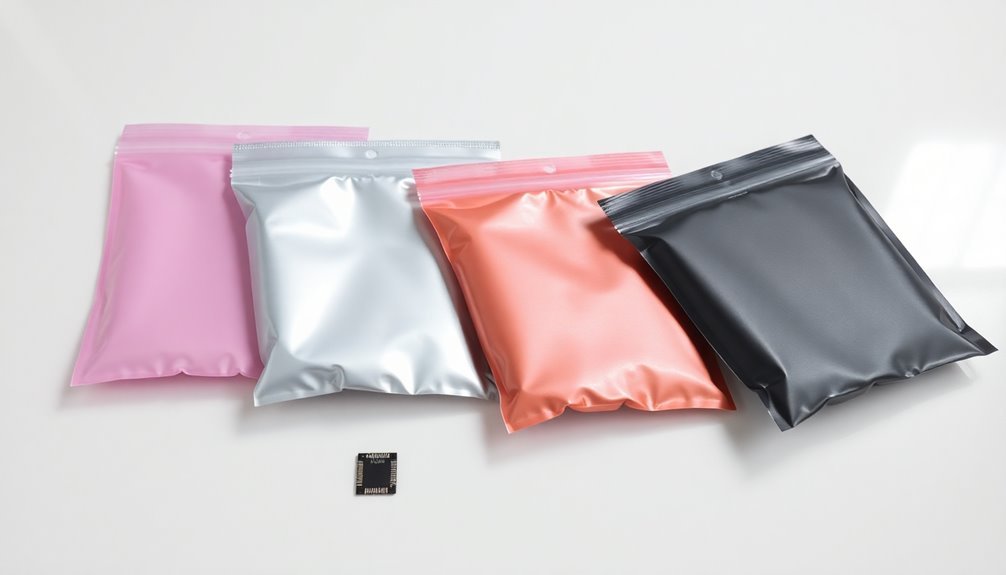
When protecting sensitive electronic components, understanding the different types of static control bags is essential for proper handling and storage.
You'll find five main types of static control bags, each designed for specific applications and protection levels. These bags also come in standard size ranges to accommodate different component dimensions.
Black conductive bags use a blend of polyethylene with conductive additives to prevent static buildup, making them ideal for handling ESD-sensitive items within protected areas.
Pink anti-static bags, made from virgin low-density polyethylene, meet military standards but don't provide shielding protection.
When you need Faraday Cage protection, static shielding bags combine polyethylene and polyester with aluminum layers to meet ANSI/ESD requirements.
For environments where moisture is a concern, you'll want to use moisture barrier bags, particularly useful in SMT and military applications.
If you're transporting delicate electronics that need both physical and static protection, bubble shielding bags offer the best solution.
Each type has different shelf lives, with anti-static bags lasting up to 2 years, shielding bags over 3 years, and conductive bags exceeding 5 years.
Consider your specific needs, including storage location and protection requirements, when selecting the appropriate bag type.
Material Properties and Protection Layers
Static control bags employ a sophisticated three-layer construction consisting of static dissipative polyethylene, aluminum, and static dissipative polyester, each serving a distinct protective function.
The aluminum middle layer acts as a Faraday cage, collecting and grounding charges while achieving less than 15nJ of static shielding protection according to ANSI/ESD-STM 11.31 standards.
The inner and outer dissipative layers work together to prevent tribocharging and remove external electrical charges, creating a complete protective environment for sensitive semiconductor components. These protective layers maintain a surface resistivity below 10^12 ohms per square, ensuring consistent static discharge capabilities.
Layer Construction Analysis
Static control bags achieve their protective capabilities through a sophisticated multi-layer construction that combines different materials with specific functions. You'll find these bags are engineered with a metalized protective layer, polyester, and static dissipative polyethylene, each serving a vital role in safeguarding your sensitive electronic components.
The layer construction provides three essential protective mechanisms:
- The outer layer's static dissipative coating prevents static buildup while handling
- A metalized layer creates a Faraday cage effect, shielding against external static fields
- The inner layer's static dissipative polyethylene protects from internal static charges
When you're selecting static control bags, you'll notice the middle polyester layer adds mechanical strength, preventing physical damage during transport and storage. Surface resistance between 10^6 to 10^9 ohms ensures optimal charge dissipation performance.
The multi-layer structure doesn't just protect against static – it's also designed to keep moisture away from your components. You can choose from thickness options ranging from 2 to 4 mil, depending on your specific protection requirements.
The construction meets rigorous standards like ANSI/ESD S541 and MIL-STD-3010 4046, ensuring your semiconductors receive reliable protection from electrostatic discharge throughout their handling and storage.
Protection Level Comparison
Protection level differences between static control packaging types create a clear hierarchy in semiconductor safeguarding.
You'll find that static dissipative packaging, with its resistance range between 1 and 1000 meg-ohms, offers basic protection against internal static build-up but won't shield your components from external charges. This makes it suitable only for non-critical environments where external ESD isn't a major concern. Next day delivery on static control bags ensures quick implementation of ESD protection measures.
In contrast, static shielding packaging provides extensive protection through its sophisticated multilayer construction. You're getting a Faraday cage effect from three essential layers: a static dissipative inner layer, a conductive middle layer (made of carbon or aluminum), and a static dissipative outer layer.
This construction protects your components from both internal and external static charges up to 20 kV.
When you're handling highly sensitive semiconductors, you'll want to confirm your packaging meets specific protection standards. Look for surface resistance within the static dissipative range (greater than 1×10^4 Ω/sq but less than 1×10^11 Ω/sq).
Don't forget to check the CDM rating of your components – a typical rating of 0.5 kV requires appropriate protective packaging to prevent ESD damage.
Key Features of Semiconductor Packaging
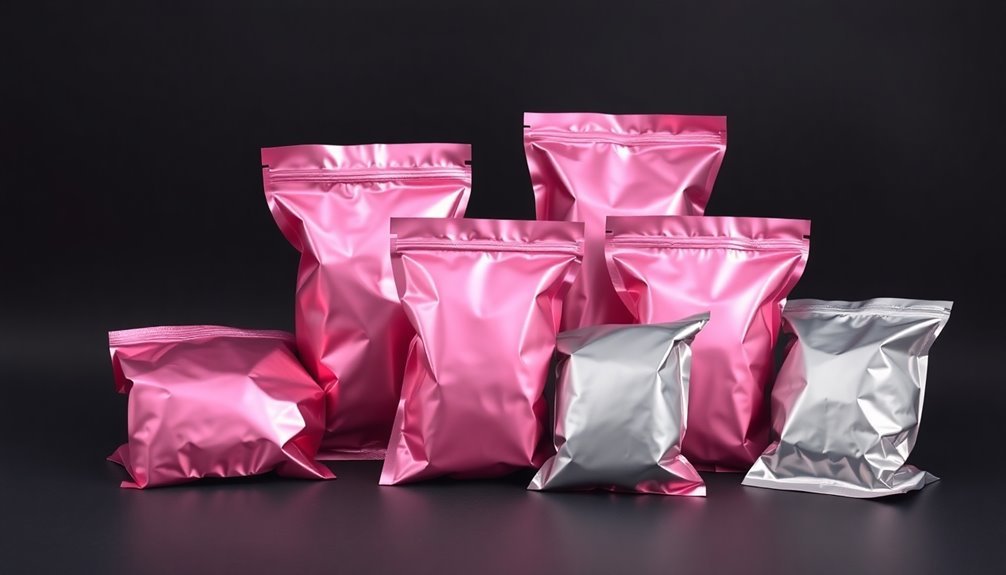
Modern static control bags for semiconductors offer you three essential layers of protection: an outer layer for physical durability, a middle metallic layer for static discharge prevention, and an inner layer that's moisture-resistant.
You'll find these multi-layer designs effectively shield your sensitive components from both electrostatic discharge and harmful moisture penetration. This layered approach mirrors the protective covering function of semiconductor packaging itself.
The bags' specialized construction guarantees your semiconductors remain protected during storage and transport, with the metallic layer dissipating static charges while the moisture barrier maintains ideal internal conditions.
Multi-Layer Protection Design
Multi-layer packaging designs have revolutionized semiconductor protection through sophisticated layering techniques and dense interconnect structures. When you're selecting protection for your semiconductors, you'll find that ball grid arrays and multi-chip modules provide exceptional density while eliminating individual packaging parasitics.
The three-dimensional integration, particularly using silicon micromachined-based packaging, offers superior isolation for components operating from 1 GHz to the terahertz range. Low-loss interconnects utilizing pyramidal shaped vias help minimize signal radiation into the substrate.
Your static control options include multiple layers of protection, each serving a distinct purpose:
- Metalized polyester exteriors combined with anti-static coatings create a complete Faraday cage effect
- Static shielding bags provide superior protection compared to basic anti-static bags
- Multilayer ceramic packages offer advanced protection through metalized, laminated, and fired ceramic tape construction
You'll need to think about thermal and electrical performance when selecting your packaging solution. The right choice depends on your specific operating temperature requirements and electrical specifications.
Remember that while pink anti-static bags prevent charge buildup, they won't shield against electrostatic discharge – you'll need proper static shielding bags for complete protection. For applications at K-band frequencies and above, vertical layering structures become particularly vital for size reduction and performance optimization.
Moisture Barrier Properties
The advanced moisture barrier properties in semiconductor packaging play a vital role in preventing component degradation and failure. You'll find that high-performance moisture barrier bags utilize materials like aluminum foil and metallized PET to achieve superior protection against water vapor and environmental threats. The incorporation of nanotechnology-enhanced composites significantly improves the overall barrier effectiveness of these packaging materials.
When selecting moisture barrier packaging, you should focus on the Water Vapor Transmission Rate (WVTR), which must be ≤ 0.0003 g/100in2/24h for effective protection.
The bags you choose should incorporate multiple layers of protection, often combining PVDC or silicone-coated materials with other barrier elements to enhance moisture resistance and mechanical strength.
You'll want to confirm your barrier bags meet Jedec compliance standards while providing essential features like chemical resistance and flexibility. The thickness and composition of the material directly affect its protective capabilities, so you shouldn't compromise on material quality.
For best results, you can pair these bags with desiccant packets and humidity indicator cards to monitor and control moisture levels. This combination creates a complete moisture protection system that's particularly critical for long-term storage of sensitive electronic components and preventing moisture-related corrosion in semiconductors.
Static Discharge Prevention
Effective static discharge prevention in semiconductor packaging relies on specialized materials engineered to dissipate electrical charges safely. You'll need to select materials that meet strict industry standards like ANSI/ESD S541 and MIL-PRF-81705E to guarantee proper protection of your sensitive semiconductor components.
Key static control options include:
- Static shielding bags that provide Faraday cage protection, blocking external static charges
- Pink anti-static bags with specialized additives meeting military specifications
- Conductive foam and materials with surface resistance between 10^2 and 10^5 ohms
When choosing your static control packaging, you'll want to evaluate the level of protection needed for your specific semiconductors. Static shielding bags offer the highest level of protection through their multi-layer construction, while anti-static bags provide basic protection for less sensitive components.
Look for materials that maintain surface resistance above 1.0 x 10^3 ohms to prevent charge accumulation. You can verify protection levels using IEC ESD simulators and guarantee your packaging meets EIA-541 static decay requirements.
Remember that proper static control extends beyond bags to include tape and reel systems for individual device protection during transport and storage.
Industry Standards and Compliance
Three major industry standards govern the manufacturing and use of static control bags for semiconductors: ANSI/ESD S20.20, ANSI/ESD STM11.11, and ANSI/ESD S541-2008. These standards outline specific requirements for ESD control programs, testing methods, and packaging specifications that you'll need to follow when handling sensitive electronic components.
You'll need to verify that your static control bags meet rigorous testing requirements using specialized equipment like concentric ring fixtures and electrometers. These tests measure electrical resistance and shielding properties under controlled humidity conditions.
The bags must also comply with ANSI/ESD STM11.31 for discharge shielding evaluation.
Your static control bags must include proper labeling with manufacturer part numbers, lot numbers, date codes, and quantities. This documentation isn't just for organization – it's a compliance requirement that guarantees traceability throughout the supply chain.
You'll also need to maintain test data and certification records to demonstrate ongoing ESD compliance.
Regular audits are necessary to verify that your packaging continues to meet these standards. When transporting ESD-sensitive devices outside protected areas, you must use static shielding bags that meet the specified resistance limits and shielding requirements.
Common Packaging Mistakes to Avoid
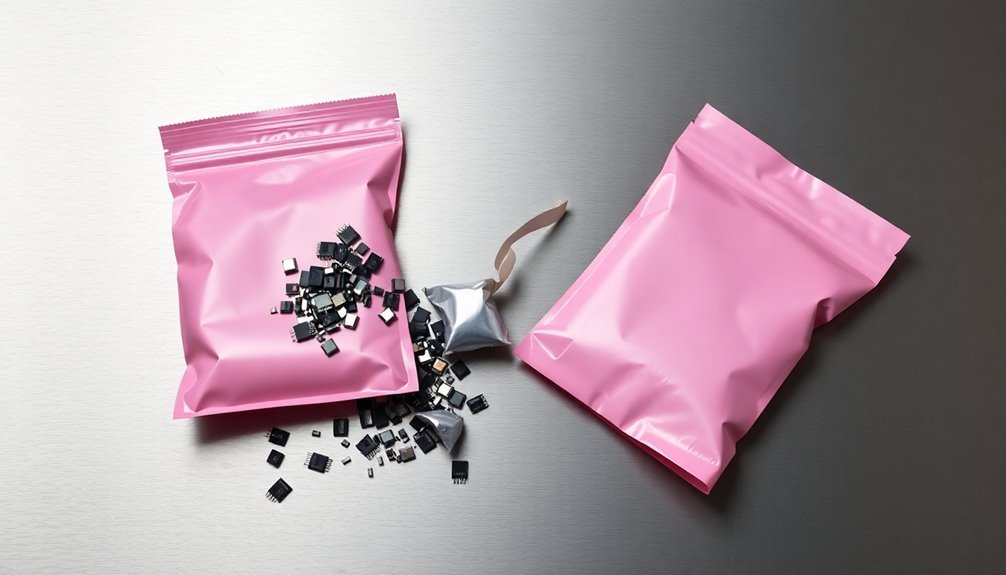
You'll find that choosing the wrong type of static control bag for your semiconductors is one of the most costly mistakes in packaging, as anti-static bags won't protect against external ESD charges like static shielding bags will.
When sealing your static control bags, you're likely to compromise their protective qualities if you don't use proper heat-sealing techniques or rely on temporary closures like tape or fold-overs.
Your attention to both correct bag selection and proper sealing methods directly impacts the safety of your semiconductor components during storage and transportation.
Incorrect Bag Type Selection
The semiconductor industry's most costly packaging mistakes often stem from incorrect bag type selection. When you're handling sensitive electronic components, you need to understand that using the wrong packaging can lead to catastrophic failures and significant financial losses.
Three critical protection requirements you can't ignore:
- Anti-static protection to prevent triboelectric charge buildup and electrostatic discharge damage
- Static shielding to guard against external electrical disturbances that can cause bond shorting
- Moisture barrier properties with desiccants to maintain a dry environment and prevent oxidation
You'll need to take into account your specific component requirements when selecting packaging materials. For instance, if you're working with semiconductor wafers, you'll require specialized cassettes and shipping boxes designed for precise handling. Standard bags won't provide adequate protection.
Your packaging must meet ANSI/ESD STM11.31 standards for energy transfer evaluation, and surface resistance must fall within the static dissipative range. Don't compromise on material quality – using non-compliant bags can result in electrical overstress, die deterioration, internal contamination, and component failure.
Always verify that your chosen packaging solution addresses all three critical protection requirements while meeting your specific component needs.
Poor Sealing Technique
Proper sealing technique stands as one of the most critical aspects of semiconductor packaging that's often overlooked. When you don't seal your static control bags correctly, you're exposing sensitive semiconductors to multiple risks, including moisture damage, contamination, and electrostatic discharge (ESD).
You'll need to pay careful attention to common sealing errors that can compromise your devices. Failing to remove excess air before sealing, incorrectly using ESD bag sealers, or not ensuring a tight seal will substantially reduce the protective capabilities of your packaging.
These mistakes often stem from inadequate training or rushing through the sealing process.
To protect your semiconductors effectively, you must implement proper sealing practices. Use appropriate ESD bag sealers or vacuum sealers, and always handle bags from the exterior to prevent static damage.
You'll also need to maintain your sealing equipment regularly and work in a clean environment to prevent contamination.
Selection Criteria for Maximum Protection
Selecting ideal static control bags requires careful evaluation of multiple protection factors, including material composition, moisture resistance, and storage requirements. You'll need to assess whether your semiconductors require basic ESD protection or thorough safeguarding against multiple threats.
For maximum protection, consider these vital factors:
- Choose metal-out shielding bags for critical electronics that demand superior ESD protection and lower resistance readings
- Select moisture barrier bags with appropriate thickness (3.6-7 mil) when humidity control is essential
- Opt for conductive bags with Faraday cage protection when you need clean, permanent ESD protection
Your storage environment plays a significant role in bag selection. If you're storing items on grounded shelves inside an EPA, basic anti-static bags might suffice.
However, if you're transporting components outside protected areas, you'll need more robust options like static shielding or moisture barrier bags.
Don't forget to evaluate physical protection needs – sharp components require thicker, more puncture-resistant materials. When handling moisture-sensitive devices, check the moisture vapor transmission rate (MVTR) and choose high-barrier options that provide thorough protection against both moisture and electrostatic discharge.
Proper Storage and Handling
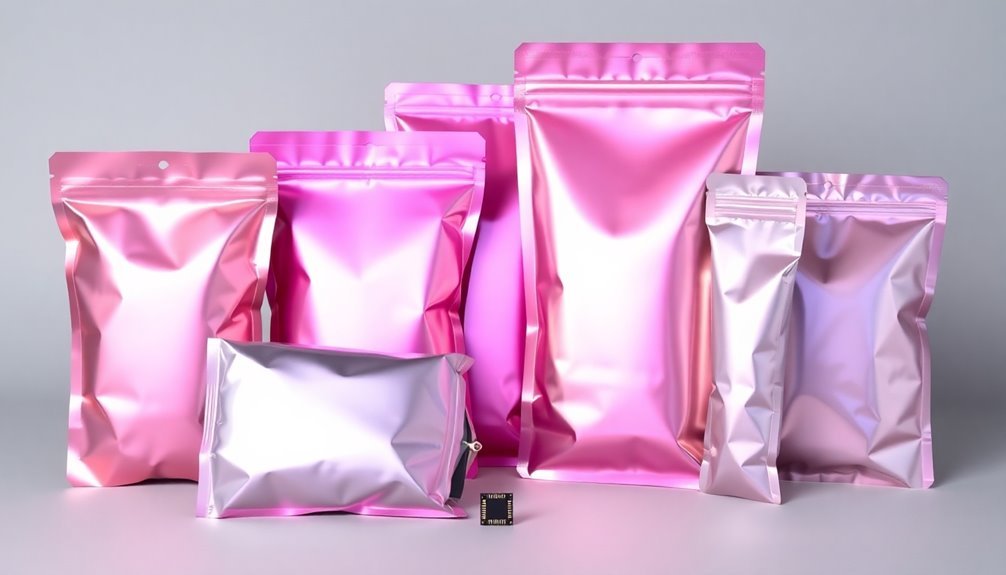
Maximizing semiconductor protection doesn't stop at selecting the right static control bag – you'll need to follow strict storage and handling protocols too. Always store your static control bags in designated ESD Protected Areas (EPA) with proper grounding to maintain their protective qualities.
You'll want to guarantee the storage environment has controlled humidity and temperature levels to prevent component damage.
When handling static control bags, you must check that they're properly sealed without any gaps that could compromise their effectiveness. If you're dealing with components that have sharp edges, add extra padding to prevent bag punctures.
Never store the bags in areas with high static electricity or extreme temperature fluctuations.
For transportation, you'll need to evaluate additional protective measures. Use temperature-controlled shipping solutions when necessary and include moisture barrier bags with desiccants to guard against humidity damage.
Remember that static shielding bags work best when combined with other protective elements like cushioning materials to absorb physical shock. Always place the bags on grounded surfaces during handling, and guarantee your workspace follows proper ESD protection protocols to maintain the integrity of your semiconductor components.
Cost Versus Protection Analysis
The balance between cost and protection requires careful analysis when choosing static control bags for semiconductors. While static shielding bags are more expensive than basic anti-static options, they provide thorough protection through their multi-layer construction and Faraday cage effect.
You'll need to weigh the initial investment against potential losses from ESD damage.
Consider these critical cost-protection factors:
- Static shielding bags cost more but protect against both ESD and physical damage, making them essential for high-value semiconductors.
- Bulk purchasing can lower per-unit costs, though you'll need accurate forecasting to avoid excess inventory.
- Warranty claims and production delays from ESD damage often exceed the cost difference between basic and premium protection.
The thickness of the bag directly impacts both cost and protection level. While 2 mil bags are more economical, 4 mil and 6 mil options offer enhanced durability for frequent handling.
You'll find that investing in proper protection upfront helps prevent costly semiconductor failures, warranty issues, and supply chain disruptions. Remember that meeting industry standards like ANSI/ESD S541 may increase initial costs but provides verified protection levels for your sensitive components.
Environmental Impact of Bag Materials
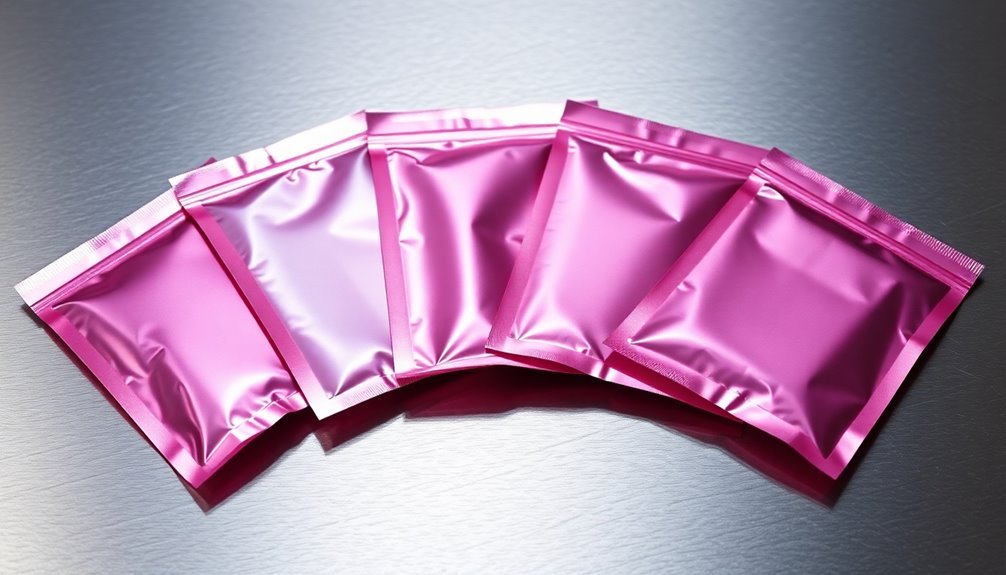
Beyond cost considerations, environmental sustainability has become a major factor in static control bag selection. When choosing materials, you'll need to weigh their environmental impact alongside their protective capabilities.
PET substrates, while offering some reduction in global warming potential, carry higher human toxicity risks due to their raw material production. FR4, though common, presents recycling challenges and contains hard-to-recover rare earth elements.
You'll want to think about the fact that standard polyethylene bags, while economical, don't provide adequate ESD protection and can contribute to waste issues. Paper-based alternatives offer clearer recycling pathways and lower global warming potential.
The semiconductor industry's significant carbon footprint – with manufacturing accounting for 74% of emissions in companies like Apple – makes your material choice even more vital.
When selecting static control bags, you can reduce environmental impact by choosing materials that align with F-gas regulations and upcoming PFAS bans. Think about alternatives like paper-based substrates or lower-temperature solder materials.
Remember that your choice affects the entire supply chain's sustainability, from raw material extraction to final disposal.
Best Practices for Sealing
Properly sealing static control bags requires both specialized equipment and proven techniques to guarantee maximum protection for sensitive semiconductors. You'll need to choose between two main sealing methods: an ESD impulse bag sealer for standard applications or a vacuum sealer for components requiring enhanced protection against moisture and static.
When you're ready to seal your static control bags, follow these critical practices:
- Press out excess air before sealing and verify that the bag's interior remains untouched to prevent contamination.
- Use appropriate ESD-safe sealing tools and verify the seal's integrity by checking for defects or weak points.
- Store sealed bags in a cool, dry environment away from direct sunlight to maintain their protective properties.
For the most effective results, you'll want to handle the bags properly during the sealing process. Always touch only the exterior of the bag and avoid rapid movements that could generate static.
If you're working with highly sensitive semiconductors, opt for a vacuum sealer to provide an additional layer of protection.
Don't forget to check that your chosen bags meet relevant industry standards like ANSI/ESD S541 and EIA 625 before sealing.
Frequently Asked Questions
How Long Can Semiconductors Safely Remain Stored in Static Control Bags?
You can store semiconductors in unopened static bags for 5+ years with MSL 3 parts and indefinitely for MSL 1/2 parts. Once you've opened the bags, storage time decreases based on environmental exposure.
Can Static Control Bags Be Reused Multiple Times?
While you can reuse static control bags if they're undamaged, it's not recommended due to reliability concerns. Check for holes, tears, or wrinkles before reuse, but it's safer to use new bags each time.
What Temperature Ranges Can Static Control Bags Withstand During Shipping?
Your static control bags can withstand temperatures between 300°F to 375°F (149°C to 190°C), but you'll want to maintain shipping temperatures around 76°F (24°C) to guarantee maximum protection of semiconductors.
Do Static Control Bags Expire or Degrade Over Time?
While static control bags don't have a fixed expiration date, they'll degrade over time. You should regularly inspect them for damage and store them properly. They typically last over 3 years when stored correctly.
Are Static Control Bags Detectable by Metal Detectors During Shipping?
You'll find that most static control bags won't trigger metal detectors, but metallized static shielding bags containing aluminum layers may be detectable. It depends on your detector's sensitivity and the bag's specific construction.
In Summary
Selecting the right static control bags for your semiconductors isn't just about cost – it's about protecting valuable components from damage. You'll need to balance material quality, protection levels, and industry compliance while avoiding common packaging pitfalls. Remember to properly store and handle your bags, use appropriate sealing methods, and consider environmental impact. When in doubt, opt for higher-grade protection to safeguard your investment.





Leave a Reply